I’ve done it. I’ve taken to painting outdoors, with all its pitfalls and rewards. So I thought I’d share my experience as it evolves.
Painting “en plien air” (or “in the open air”) has a long history, most notably being the method preferred by the impressionists. It has its challenges and its rewards. This summer I have taken the “plien air” plunge and decided to give this method of painting a run. Early results are not so good, but I’m determined to stick with it and see where it takes me.
A little history. Prior to the mid-19th century it was difficult to paint out of doors with all the equipment necessary, but the introduction of paint in tubes and the box easel (portable) made it much easier to carry paint and equipment with you outside to paint on-site. This dovetailed nicely with the rise of impressionists like Monet, Pissaro and Renoir who believed in capturing real-life and “painting the light” outdoors. I won’t bore you with more history other than to say painting “en plein air” became very important to impressionist painting and changed how the world looked at art.
For me, the attraction of painting outdoors is that you truly can not capture a scene with a camera or memory, or the light and the colors, as well as when you are standing there at your easel looking at your subject. Being outdoors by itself is great, most of the time. And there is something romantic about painting a picture all in one session right there on the spot. Its not necessary to complete a painting in one session, Monet famously would take several canvases with him and paint on each for only a few minutes at the same time of day, returning each day so as to capture that exact light and time of day. But it is common practice for many to paint in a single session. And there are plenty of very accomplished and successful artists who will only paint this way, outdoors, rain, shine, summer or winter.
So I have painted this way now a total of 5 times. The results of which are 5 paintings that are not worth displaying. But I’ll share this last effort and what I have been learning for a couple of reasons. One, its worth showing and talking about the challenges as a learning tool. Two, it will be good to gauge my progress as I paint outdoors more and more. And three, since I will be participating in two “plein air” festivals in the coming weeks, and taking a weekend workshop in August which will be mostly outdoor painting, its good to think about the experience so far and plan for what I need to improve on.
The photo that leads this blog post shows both the painting and the scene painted in the background. This site is one of the sites for the upcoming Jericho Plein Air Festival taking place this Saturday. Since I am new to this, I decided to go to one of the sites I have chosen to paint at, and give it a shot before the actual festival to get familiar with the subject I plan to paint.
It was a perfect morning, not too cold or hot, nice light, and beautiful scenery. This is a series of beaver ponds in Jericho Vermont. I set up and started painting like I usually do at home, with a few variations. Painting outdoors takes more planning and preparation. I try to carry fewer paints, and fewer brushes for one thing. But you also have to plan for carrying water, sunscreen, shade (hat, umbrella), bug spray, along with the usual easel and painting surface (canvas). I leave mediums at home but do carry a spray bottle to help keep paints moist.
Challenge number one for me is that on a dry warm day the paints dry FAST. So painting this way definitely benefits those that can paint quickly. Strike one against me since I usually take my time. And I usually paint some, sit and think about it a bit, paint some more, get a snack, paint some more, sleep, think some more, and then repeat until I feel I am ‘done’.
Not happening when painting outdoors. But that is one of the benefits I see is that it will force me to change how I approach a painting. Thinking it through ahead of time more completely and then working quickly. All the things I have been reading and learning I now have to practice.
- simplify the composition
- boil it down to 3-4 value shapes
- establish your lights and darks first
- put down your initial colors for later reference
- keep the painting loose and paint quickly
- don’t fuss with details
Just some of what I need to learn to do better. I actually video-taped this experience with the intention of having a running commentary about the process and what I was going through, but my clip-on microphone had a dead battery. I may still post the video to youtube, but I’ll have to now go back and add commentary and that takes some time.
So here I am getting the composition sketched out and trying to keep it simple.
and here I am trying to establish a value map using just burnt sienna and white. Already though I am running into problems. But I push on.
I establish my darks, with the large pine at the left edge of the pond being the focal point. This is where I want my darkest dark and greatest contrast against the light sky and reflected sky in the pond. And I am trying to quickly get underlying color down for the water that I will paint reflections over later. The sky and water should interact with each other and create some balance, but already I have issues with intensity. I figure I can adjust that later with glazing, and push on.
Working my way around the canvas now I am trying to get paint on all the white surfaces. Starting with my darkest shadow color so I can paint from dark to light later on adding highlights last. But already I have fallen into my usual trap of working too closely to the actual subject. Instead of a loose impression of the landscape I am trying to “capture” it in form and detail already this early.
What you don’t see is that by now, probably close to an hour into this, paints are continually drying on the palette and I have to keep adding paints. If I add too much, it dries. However I have learned that even if it skims over, I can break the skin of a larger pile of paint and use the wet paint underneath. I try to keep spraying the palette with my spray bottle, but its easy to forget.
So here I have covered the canvas and started going back to add mid-tone values in the far trees and grasses at the end of the pond. I had a friendly visit by another member of the Essex Art League who is also going to paint in the Festival this weekend, and she reminded me to step back and look from a distance.
One of the advantages of painting this way is you can step back and position yourself so that your painting is right in the scene you are painting. So you can see if your values and colors are matching up with the actual scene. Mine aren’t. Way too dark for one thing. So I know I have to go back and continue to add lighter colors. Now its getting hot. And I am getting a little tired.
If you compare the above photo to the one just prior to that you can see that I have gone back and lightened the back hill and the trees in the distance. My focal point, the big pine on the left, just didn’t have enough contrast to stand out and draw your attention. Its now better, but its not how I set out to paint it.
At this point I am resolved to finish up and learn from this experience. I know its not a great effort and there are lots of things I “want” to do differently this weekend when I go back, but from experience I can not always execute what I have in mind. So I may attempt to paint this from a photograph trying some different things to see if I can get closer to the look and feel I envisioned in my head. By practicing some of this I hope that when I go back it is a little easier to execute.
Of course the light may be different, and the weather, but that is part of the challenge, and the fun, of plien air painting.
I will post sometime after the event and if I manage to complete this painting a 2nd time “en plein air” we can compare and see how I did. And over the course of the next few months I’ll try to write one or two more posts comparing and measuring my progress with this type of painting. The finished result is at the bottom of this post.
However let me leave on a positive note. Painting outdoors is rewarding. You can never capture the feeling of a place as well as when you are actually there. Something about the spirit and feeling, what you are seeing, gets captured when you paint on the spot that you can’t hope to capture from memory or with a photograph. So grab your paints, your canvas, (and don’t forget your bug spray) and get outdoors!
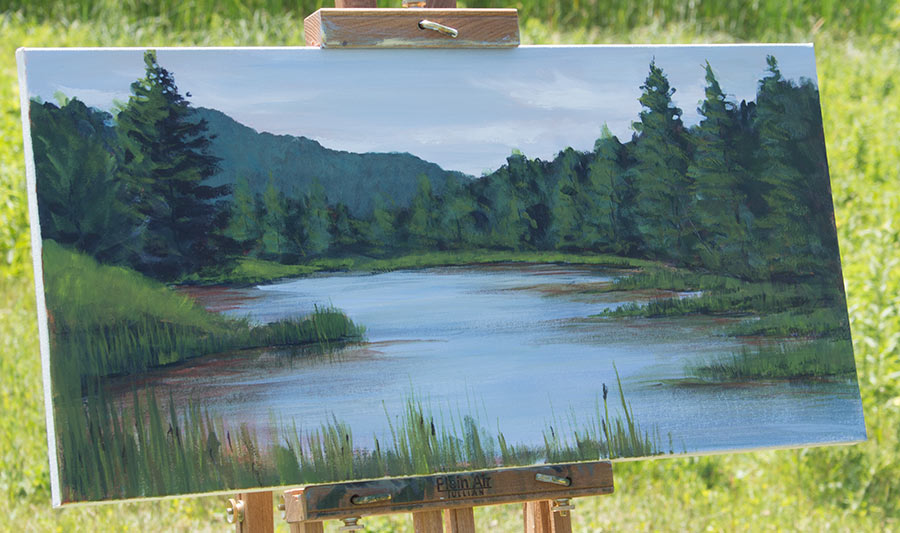
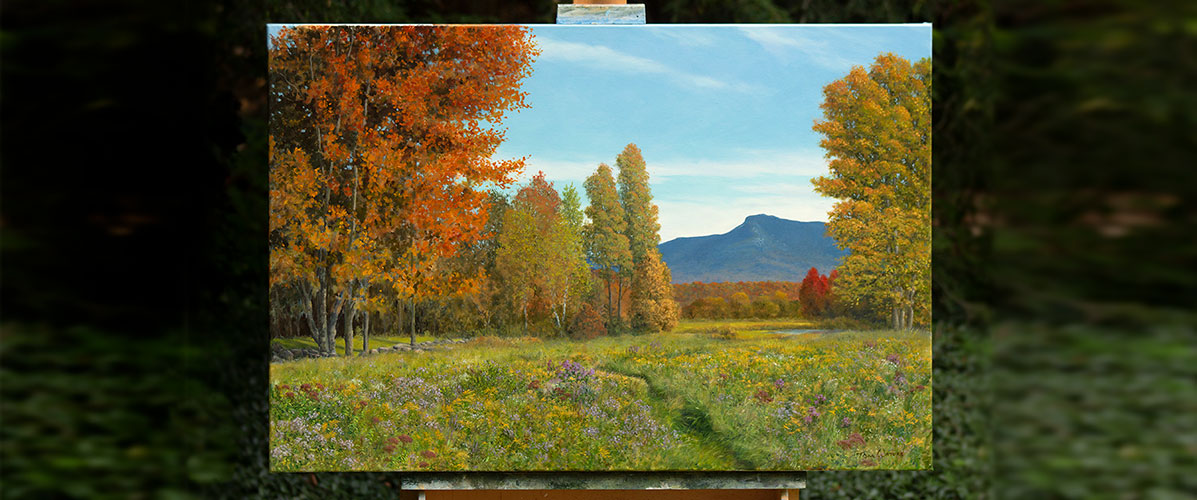

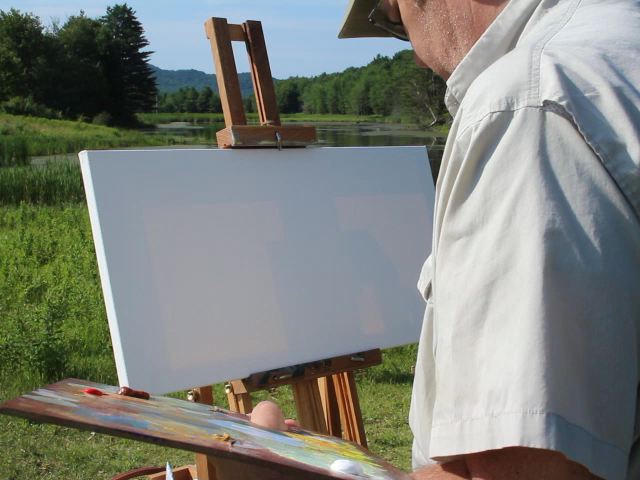
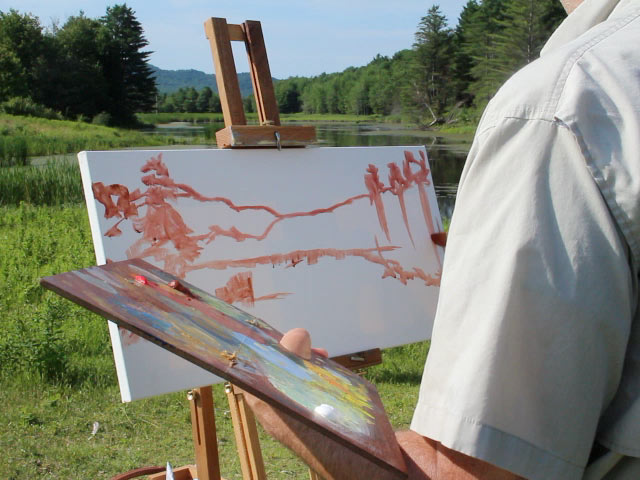
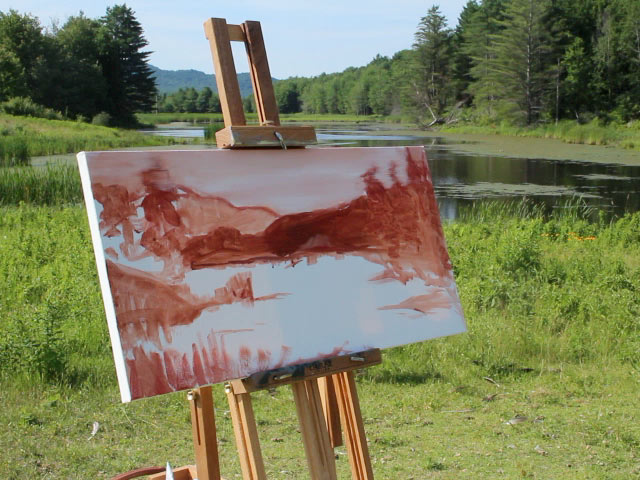

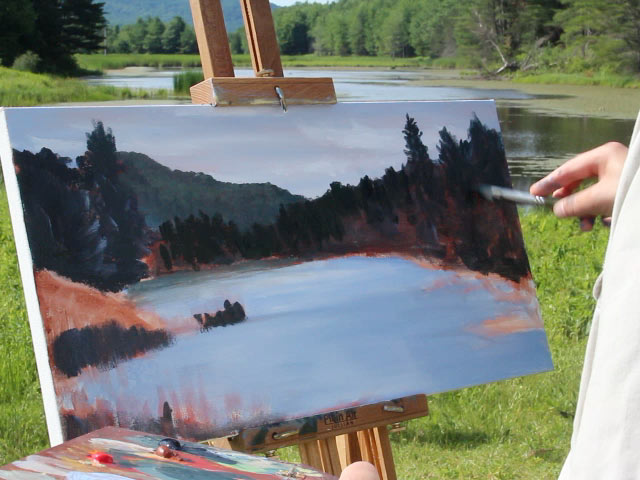
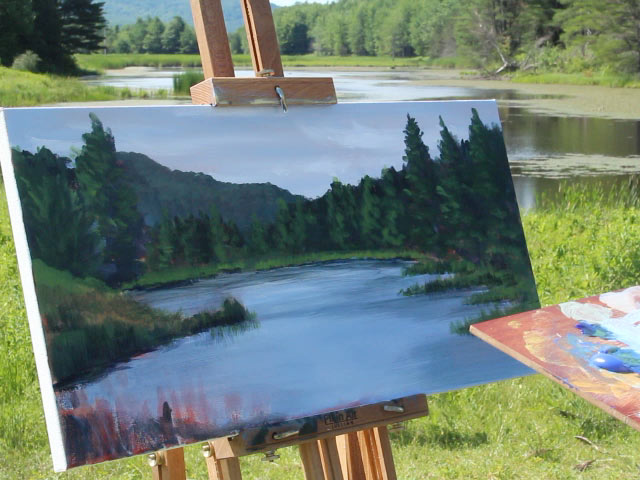
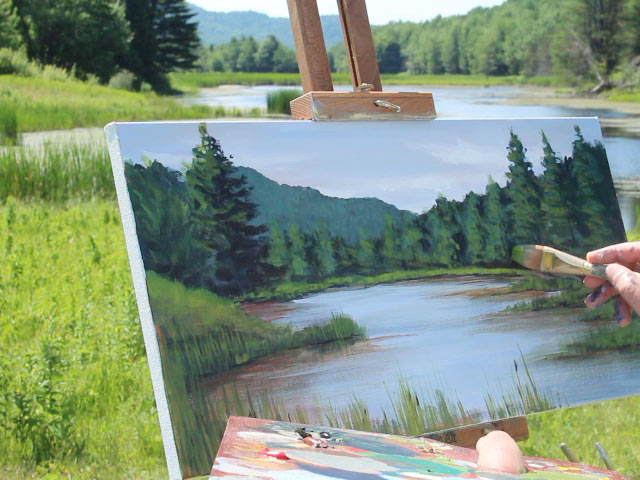
WONDERFUL, and I refuse to dilute that description with…”for a first try.” I have 2 esals now…one for outdoor painting, and a well used desktop easel with a drawer for all the ecruman to carry along. But I don’t carry it anywhere! The outdoor easel with collapsible legs remains pristine. I think you have given me the impetus to venture out. I live in the beautiful White Mountains of New Hampshire, and everywhere I look there are landscapes to paint as well as water to dip one’s toes into. Just down our road is a constantly enlarging beaver hut and corresponding pond; almost a lake since last summer. If I lived there I’d be worried about the rising water’s edge. I’m only able to live here for 6 months or so in the summer; Florida in the winter. I obviously prefer it here, but my husband abhors the massive snowfalls in Bethlehem, our little town, just outside of Littleton (and in case you have not heard it is now officially called “THE GLAD TOWN” after the Pollyanna book & movie. Banners, Flags and signs galore all proclaiming that Littleton is now “the Glad town.” If you ever get over this way your breath will be taken away with it’s beauty. I have only been painting for 18 months or so, and have already sold 3 paintings (in Vermont) at a Bakery/Deli next to “The Vermont Country Store”, (famous for their catalog, and unusual stock). It was a trio of hummingbirds 12×12 framed. She used them to decorate the bakery/Deli Ladies Room. HA. I was proud. Once again visit the White Mountains and you will forever call the Green Mountains of Vt,…well, hills. Warm regards, Debra Artigliere
Debra, I encourage you to get out there and paint. If nothing else its great excuse to be outdoors on a beautiful day and admire the scenery. I think you’ll enjoy it. And I am familiar with the White Mountains. In fact I am going to attend a weekend workshop with Becky Joy working out of the Group 8 gallery in Jackson in August. If the weather is good we’ll be painting outdoors. I also have only been painting 18 months. Its quite a lot to learn eh? Good job selling some of your work, you have outnumbered me in sales! The Vermont Country Store is quite the place…. And I am ignoring the slight of the beautiful Green Mountains 🙂 Thanks for your comments. Much appreciated.